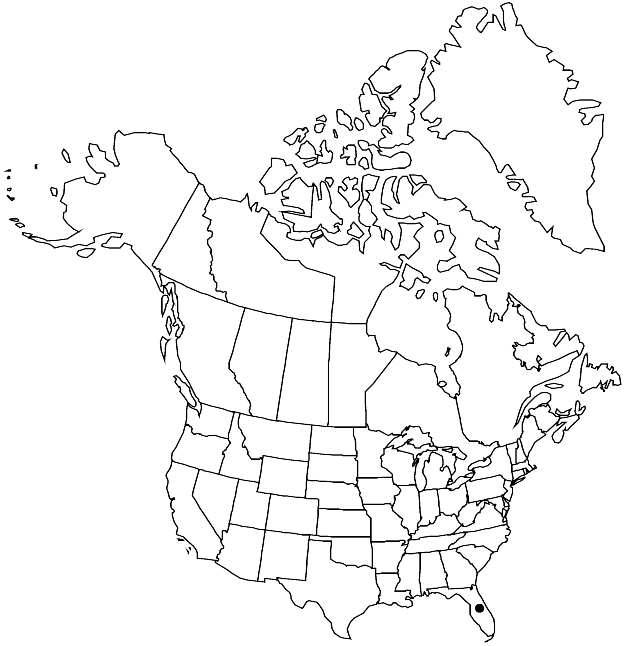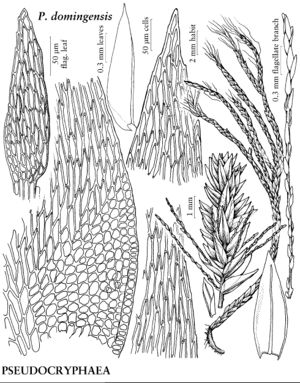Difference between revisions of "Pseudocryphaea domingensis"
Bryologist 83: 455. 1981.
FNA>Volume Importer |
FNA>Volume Importer |
||
| Line 18: | Line 18: | ||
|name=Cryphaea leptoclada | |name=Cryphaea leptoclada | ||
|authority=Sullivant | |authority=Sullivant | ||
| − | }}{{Treatment/ID/Synonym | + | }} {{Treatment/ID/Synonym |
|name=Leucodon domingensis | |name=Leucodon domingensis | ||
|authority=(Sprengel) Mitten | |authority=(Sprengel) Mitten | ||
| − | }}{{Treatment/ID/Synonym | + | }} {{Treatment/ID/Synonym |
|name=Pseudocryphaea flagellifera | |name=Pseudocryphaea flagellifera | ||
|authority=(Bridel) E. Britton | |authority=(Bridel) E. Britton | ||
| − | }}{{Treatment/ID/Synonym | + | }} {{Treatment/ID/Synonym |
|name=Pterigynandrum domingense | |name=Pterigynandrum domingense | ||
|authority=(Sprengel) Hampe | |authority=(Sprengel) Hampe | ||
| Line 41: | Line 41: | ||
|elevation=low to moderate elevations (0-1200 m) | |elevation=low to moderate elevations (0-1200 m) | ||
|distribution=Fla.;West Indies;Central America;n;c South America. | |distribution=Fla.;West Indies;Central America;n;c South America. | ||
| − | |discussion=<p>Pseudocryphaea domingensis is distinctive among North American mosses by its combination of julaceous stems, flagellate branches, and 1-costate leaves with elongate, prorulose cells; it is unlikely to be confused with any other moss. Depauperate, eflagellate plants have been misnamed Henicodium geniculatum, but in that species the costa ends well before the apex and the cells are 1-papillose over the lumina.</p> | + | |discussion=<p><i>Pseudocryphaea domingensis</i> is distinctive among North American mosses by its combination of julaceous stems, flagellate branches, and 1-costate leaves with elongate, prorulose cells; it is unlikely to be confused with any other moss. Depauperate, eflagellate plants have been misnamed <i>Henicodium geniculatum</i>, but in that species the costa ends well before the apex and the cells are 1-papillose over the lumina.</p> |
|tables= | |tables= | ||
|references= | |references= | ||
| Line 64: | Line 64: | ||
|publication year=1981 | |publication year=1981 | ||
|special status=Selected by author to be illustrated | |special status=Selected by author to be illustrated | ||
| − | |source xml=https://jpend@bitbucket.org/aafc-mbb/fna-data-curation.git/src/ | + | |source xml=https://jpend@bitbucket.org/aafc-mbb/fna-data-curation.git/src/8f726806613d60c220dc4493de13607dd3150896/coarse_grained_fna_xml/V28/V28_412.xml |
|genus=Pseudocryphaea | |genus=Pseudocryphaea | ||
|species=Pseudocryphaea domingensis | |species=Pseudocryphaea domingensis | ||
Revision as of 17:05, 18 September 2019
Plants to 6 cm, often shorter. Stems with external cells in one layer, enlarged, reddish, walls firm, subtended by ca. 5 layers of small thick-walled reddish cells, internal cells larger, walls thinner, hyaline; pseudoparaphyllia narrowly to broadly foliose, when broad often incised; axillary hairs apparently 2 per axil (1 per axil in flagellate branch leaves), distal cell often with granular contents. Leaves 1–1.7(–2) mm; alar cells extending up margins 30–40 cells; laminal cells 6–8:1. Specialized asexual reproduction by flagellate branches to 4–5 mm, 70 µm diam. including leaves; leaves 0.2 mm, alar cells few, laminal cells 3–4:1.
Habitat: Tree trunks, rock, fairly dry to mesic forests
Elevation: low to moderate elevations (0-1200 m)
Distribution

Fla., West Indies, Central America, n, c South America.
Discussion
Pseudocryphaea domingensis is distinctive among North American mosses by its combination of julaceous stems, flagellate branches, and 1-costate leaves with elongate, prorulose cells; it is unlikely to be confused with any other moss. Depauperate, eflagellate plants have been misnamed Henicodium geniculatum, but in that species the costa ends well before the apex and the cells are 1-papillose over the lumina.
Selected References
None.
